Arthur Hardy looks back at 50 years of Mardi Gras in New Orleans
A CELEBRATION OF CARNIVAL

On the Cover
Rex’s Butterfly King float heads down St. Charles Avenue on Mardi Gras day in New Orleans on March 1, 2022.
DAVID GRUNFELD / THE TIMES-PICAYUNE | THE ADVOCATE
OPPOSITE: The Jester float awaits Mardi Gras day inside the Rex Den on February 7, 2013.
MICHAEL DEMOCKER / THE TIMES-PICAYUNE
Special thanks to Annette Sisco, Features Editor - The Times-Picayune
No part of this book may be reproduced, stored in a retrieval system or transmitted in any form or by any means, electronic, mechanical, photocopying, recording or otherwise, without prior written permission of the copyright owner or the publisher. Published by Pediment Publishing, a division of The Pediment Group, Inc. www.pediment.com. Printed in Canada.

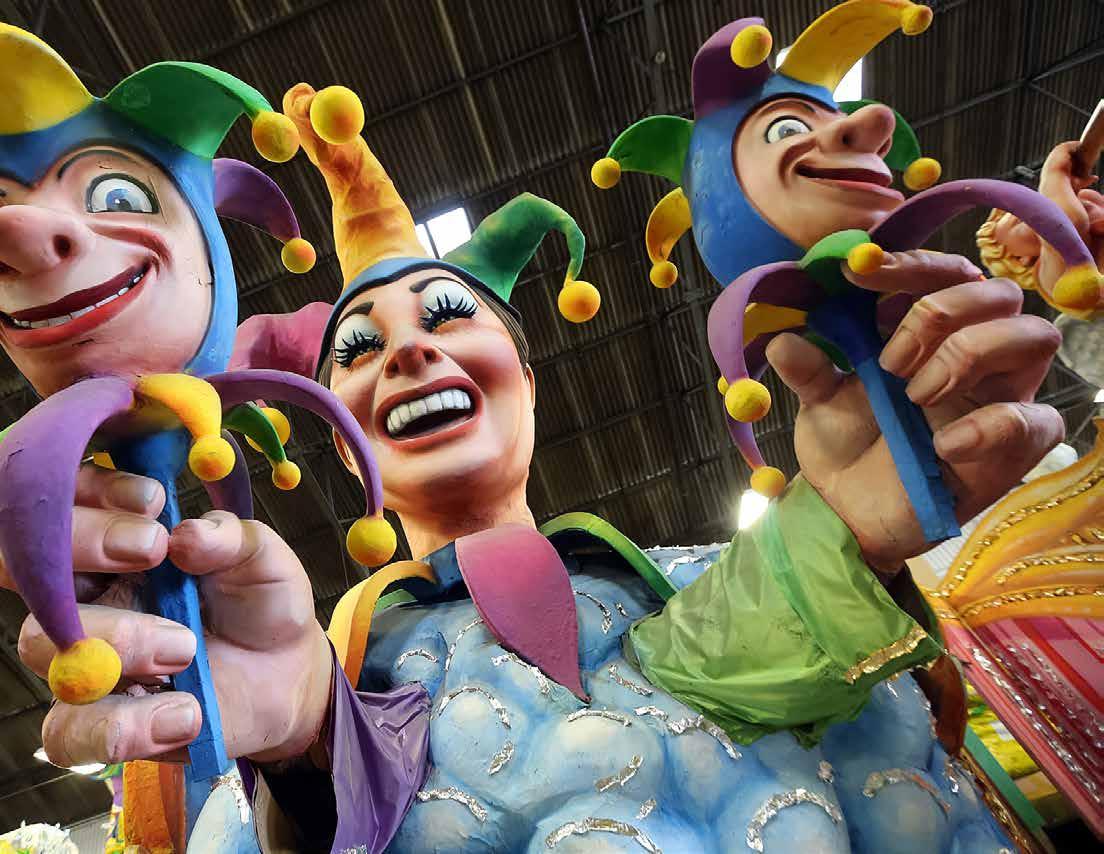







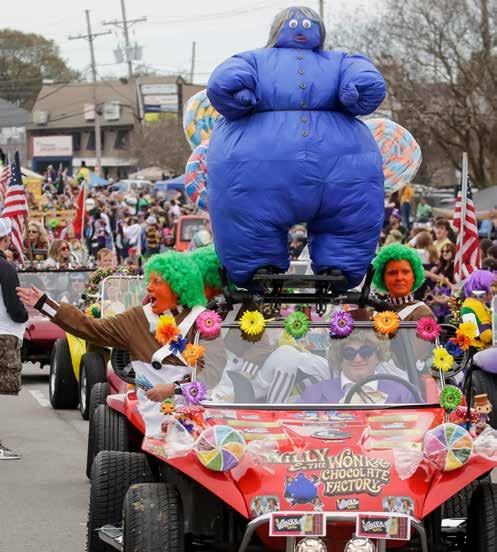


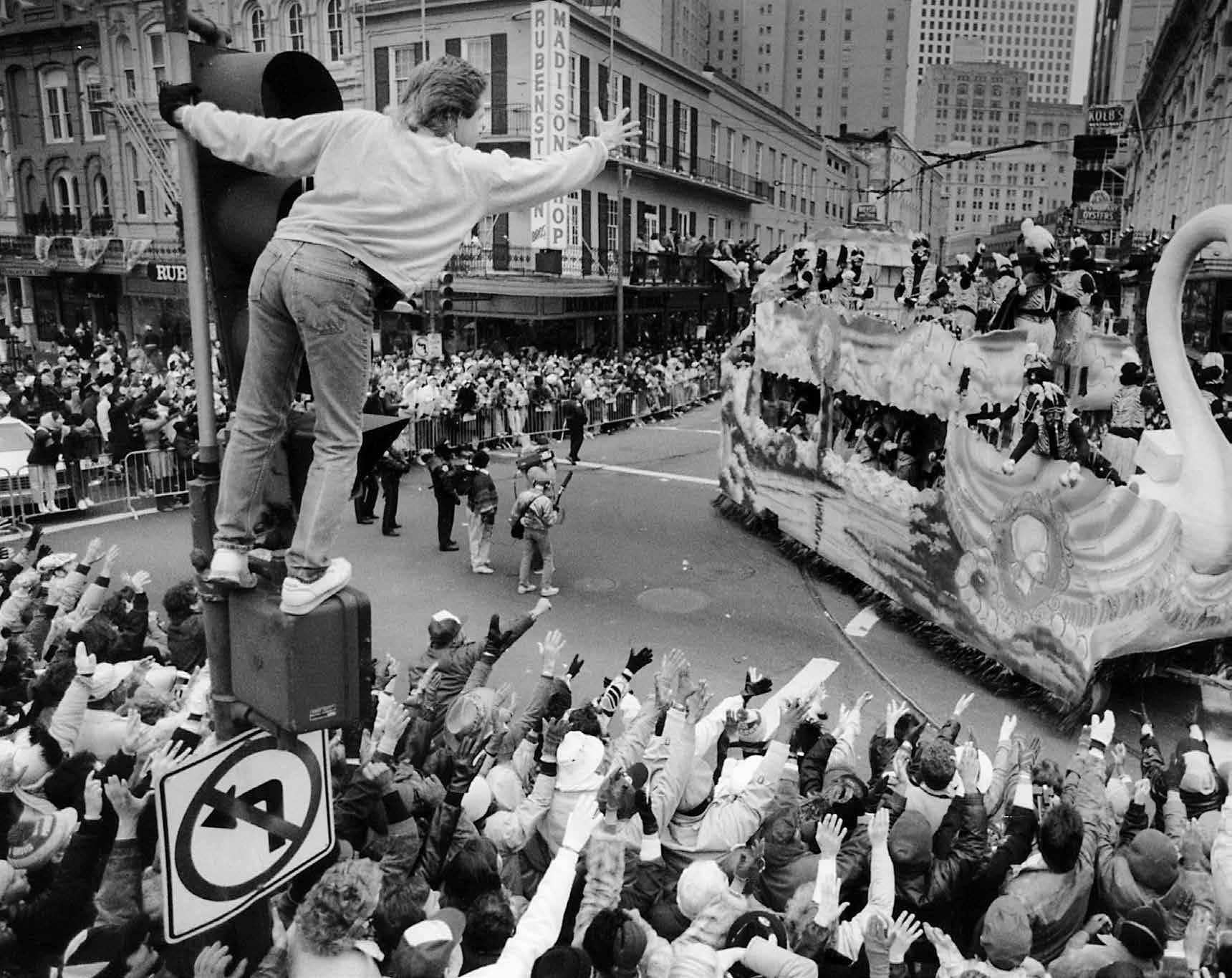
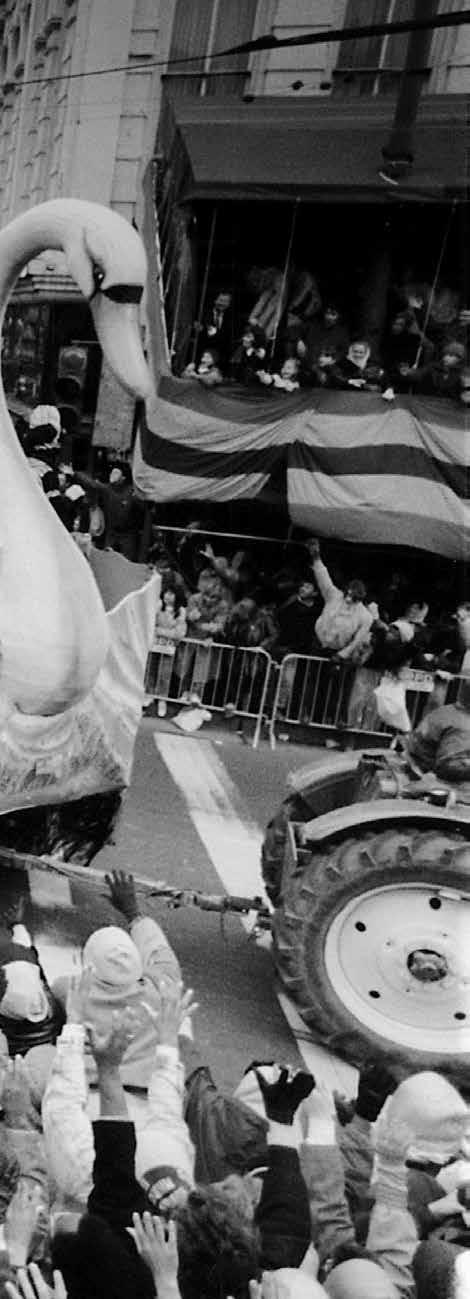
1977-2026
A Fifty-Year Overview
BY ARTHUR HARDY
The timeless traditions of Mardi Gras are treasured by generations of families. Yet, Carnival too is impacted by world events, and change is inevitable.
In the past 50 years, the Mardi Gras Guide has documented both the tradition, and the evolution, of New Orleans’ signature celebration.
As chronicled in the Mardi Gras Guide, the four most significant stories we covered were the 1979 police strike, the 1991 anti-discrimination ordinance, the 2006 recovery from Katrina Carnival, and the 2021 Covidcanceled Carnival.
Twenty-two of 2025’s parading krewes were included in the first Mardi Gras Guide in 1977. There have been significant changes and growth since then. Some 74 new krewes have been founded, but 50 of those clubs folded. In terms of their impact on Mardi Gras, the most important new krewes since
1977 include Caesar, Chaos, d’Etat, Femme Fatale, King Arthur, Orpheus, Muses, Nyx, and Poseidon (Slidell).
The geography of Carnival has changed with the abandonment of neighborhood parades, in favor of a standardized route in New Orleans. The area of greatest sustained growth has been St. Tammany Parish. While parades in metro New Orleans once rolled on every day of the season, Chalmette now has only one parade day, and Metairie’s parade schedule has been reduced to six days.
The scheduling of parades has also changed and now includes double and triple header evenings. Mardi Gras weekend now draws greater crowds and higher hotel occupancy than Fat Tuesday; however, the first weekend of the season features more parades. Ancillary events such as Family Gras in Metairie and Samedi Gras, Endymion’s
pre-parade party, have added to the 12 days’ festivities.
Because of NOPD’s shortage of manpower, since 2023 police from other jurisdictions have helped patrol parade routes.
Krewe membership has increased extensively and become more diverse, with five new Black krewes being formed and with female clubs ever expanding in membership. Female and coed clubs now stage 77% of all parades. Endymion had 700 members in 1977. By 2025 a dozen parades topped 1,000 members, with Iris leading with 3,600 members. Zulu and Cleopatra have more than quadrupled their memberships.
The growth in the number, artistry, and size of preseason alternative parades such as Chewbacchus has further diversified participation. The addition of adult marching groups such as the Rollin’ Elvi, the Pussy Footers, and the
OPPOSITE: Ted Straussnig of Slidell stands on the traffic light at the corner of Canal Street and St. Charles Avenue watching the Zulu Parade. CHUCK COOK / THE TIMES-PICAYUNE
Muff-a-Lottas, offers more opportunities for non-krewe members to join in the fun. The Krewe of Barkus, the first canine parade, was founded in 1993.
The AIDS epidemic in the 1980s seriously impacted the Gay Carnival ball schedule, but thankfully most clubs have returned in full force.
January 6—Twelfth Night—the official opening of the Carnival season, traditionally featured only the private ball of the Twelfth Night Revelers. Thanks to the addition of the Phunny Phorty Phellows, two other streetcar groups, and the St. Joan of Arc parade in the French Quarter, the evening is now filled with celebrations.
Likewise, Mardi Gras Eve once only featured the Proteus parade and ball. That changed in 1981 with the birth of Rex’s Lundi Gras celebration at the Riverfront, which grew to include Zulu’s all-day festival at Woldenberg Park in 1993.
The construction of signature floats and of super tandem floats reached its zenith with Endymion’s nine-unit Pontchartrain Beach float in 2013.
The return of satire in parade titles
in New Orleans in 1990. Frank Hopper, the flag boy for the Mohawk Hunters, keeps the way clear chanting and singing “get out the way.”
THE TIMES-PICAYUNE
OPPOSITE: Rex, King of Carnival welcomes parade goers on Canal Street.
G.E. ARNOLD / THE TIMES-PICAYUNE


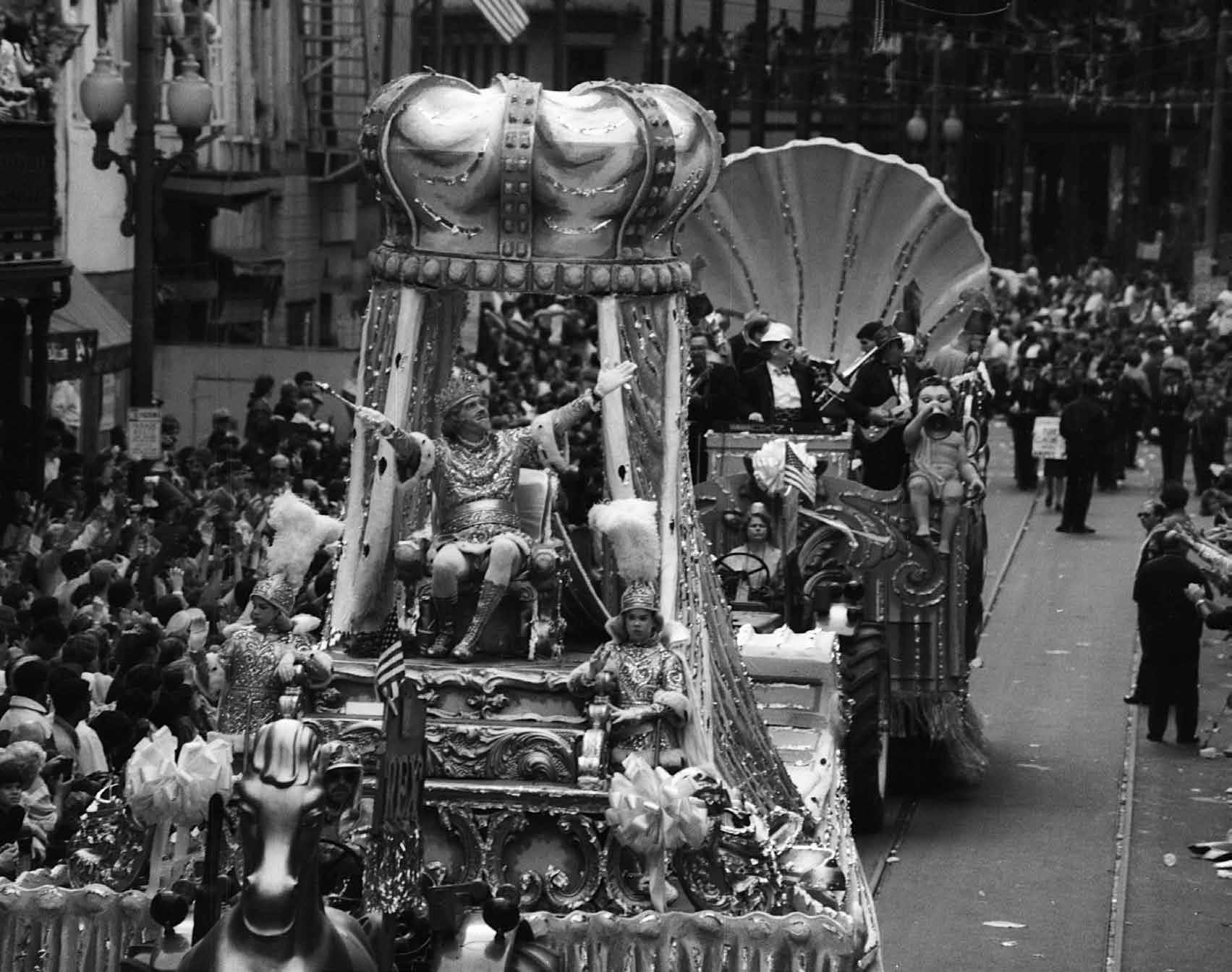
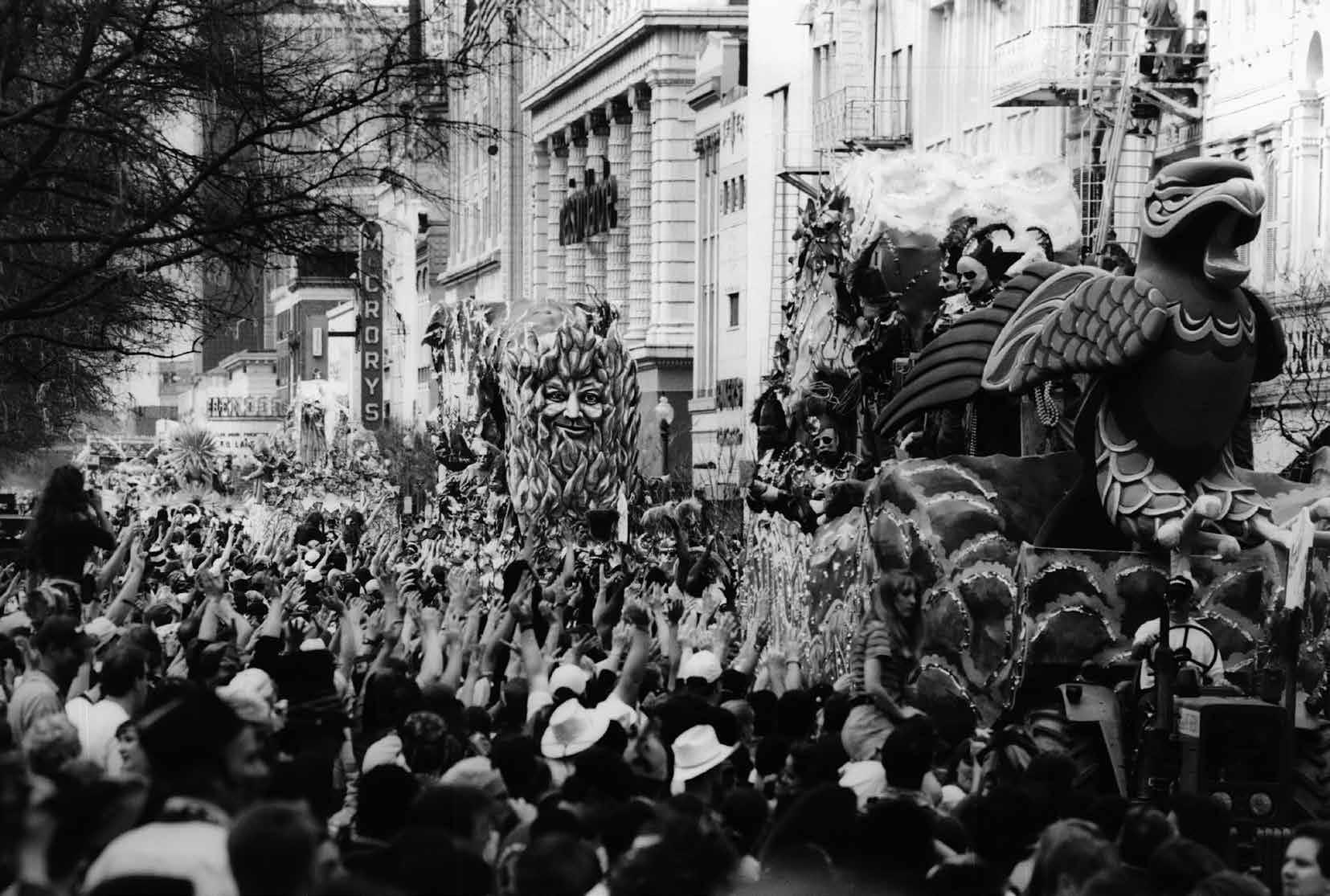
and themes has been notable in krewes such as Chaos, d’Etat, Druids, Muses, and Tucks, and in the alternative club, Krewe du Vieux.
The custom of featuring celebrity guests in parades peaked in 1982 when 12 clubs featured imported stars. Now only Bacchus, Endymion, and Orpheus continue the tradition.
The quantity and quality of truck parades has declined in the past decade.
When Covid canceled Mardi Gras parades and balls in 2021, the junior class of college debutantes, which had traditionally provided royalty for oldline krewes, had instead, to be presented in their senior year. This change has continued through the present day.
While in the late-1980s the national image of Mardi Gras was that of “Girls Gone Wild,” the (correct) perception now of the celebration is that it is a family friendly event.
The throw industry has greatly expanded. Where inexpensive doubloons, plastic beads and cups once were the industry’s mainstay, elaborate krewe signature throws are now the most prized items. Today, the movement to more environmentally friendly throws has gained momentum.
With the Municipal Auditorium still shuttered since Hurricane Katrina, new venues for Carnival balls have included the Morial Convention Center, the Pontchartrain Center, the New Orleans Country Club and the grand ballrooms of downtown hotels.
The king cake industry has exploded

since the late 1970s, as has the popularity of Mardi Gras apparel and house decorations. Mardi Gras posters have lost their popularity.
The business of Mardi Gras now includes exporting props and supplies to other cities that stage Mardi Grasthemed events. Many conventions in New Orleans include a Mardi Gras component to their meetings. Mardi Gras World on the riverfront offers visitors a yearround opportunity to explore Carnival.
Jefferson Parish Sheriff Harry Lee’s policy to charge higher parade fees for a new krewes was ruled unconstitutional in 2005.
Legalized gambling in Louisiana dried up charity bingos, a major source of funding for Carnival clubs. Increases in dues and the sale of throws to members help make up the shortfall.
Philanthropy has become a mission of several clubs, most visibly with Rex, Hermes, Muses, and Zulu.
ABOVE: Florinda Garcia can’t contain her excitement after getting deluged with kisses and beads from the Jefferson City Buzzards as they meander the streets toward St. Charles Avenue.
TED JACKSON / THE TIMES-PICAYUNE
OPPOSITE: Rex parades down Canal Street in 1996. THE TIMES-PICAYUNE
Despite a fire at its headquarters, the Knights of Momus paraded with members wearing firemen’s suits in a satirically-theme procession. The Krewe of Bacchus became the first Mardi Gras club to parade in the Louisiana Superdome. New krewes of Aquila debuted in Metairie, Selena and Minerva in New Orleans East, and Hestia Uptown. The year saw the cancellation of St. Bernard’s Aquarius parade just hours before it was scheduled to roll. As clubs moved away from the traditional tableau ball format and sought out newer venues such as hotel grand ballrooms, the Municipal Auditorium schedule diminished with only 20 of the 51 parading krewes staging balls there, down from an all-time high of 68 events (including non-parading clubs) just four years earlier.



LEFT: Maskers on the Boeuf Gras float throw gifts to the crowd.
BRYAN S. BERTEAUX /
THE TIMES-PICAYUNE
BELOW: First-grade teacher Mrs. Aloha Collins looks over the handiwork of some of her Bienville Elementary School students who participated in the school’s fifth annual miniature Mardi Gras float contest.
WILLIAM F. HABER /
THE TIMES-PICAYUNE


ABOUT THE COVER 1977–1983
Long time family friend and award-winning graphic artist Anthony DiMarco served as our young publication’s art director. He created the first cover, depicting a masked riding Lieutenant tossing a doubloon, accompanied by a costumed reveler. It would be used in various colors through 1983.
1989
The final Fat Tuesday of the decade was early—February 7—and it was a cold one, with a low of 36 degrees. A new trend picked up steam in 1989 as conventions started including a Mardi Gras element to their meetings, no matter when they were staged. Mini-floats were often paraded through grand ballrooms to the delight of visitors. Several krewes capitalized on this by staging “repeat” balls for out-of-town guests. As the doubloon celebrated its 30th anniversary as a throw, it continued to lose its popularity, as eight clubs discontinued the item in favor of cups, coasters, and frisbees, which had become more popular. Reigning as Bacchus was Billy Crystal. The Krewe of Ulysses paraded for the first time in Gretna.

ABOVE RIGHT: Willie Hicks holds his flambeaux at the start of the Babylon parade on Napoleon Avenue near Prytania Street. KATHY ANDERSON / THE TIMES-PICAYUNE
OPPOSITE TOP: Manuel Ponce of Kern Studios puts finishing touches on the “Cotton Press Monster” for the Rex parade. TED JACKSON / THE TIMES-PICAYUNE
OPPOSITE BOTTOM RIGHT: Rex members, their families and others view the krewe’s floats at a float preview party in the krewe’s den. MATT ROSE / THE TIMES-PICAYUNE
OPPOSITE BOTTOM MIDDLE: A masker throws beads from his float in the Rex parade as it rolls down St. Charles Avenue, near Jackson Avenue. MATT ROSE / THE TIMES-PICAYUNE
OPPOSITE BOTTOM LEFT: Gina Clark, 10, of Gretna tries her own way to attract the attention of the riders in the truck floats that followed Rex.
DARLENE PIERCE / THE TIMES-PICAYUNE
RIGHT: Charles Taylor, Chief of the White Cloud Hunters Black Masking Indians, smiles from his bright yellow headdress. TED JACKSON / THE TIMES-PICAYUNE
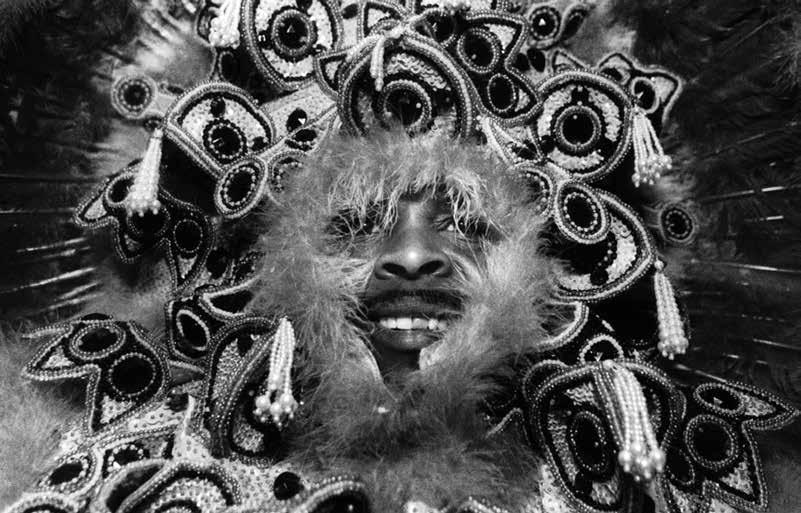
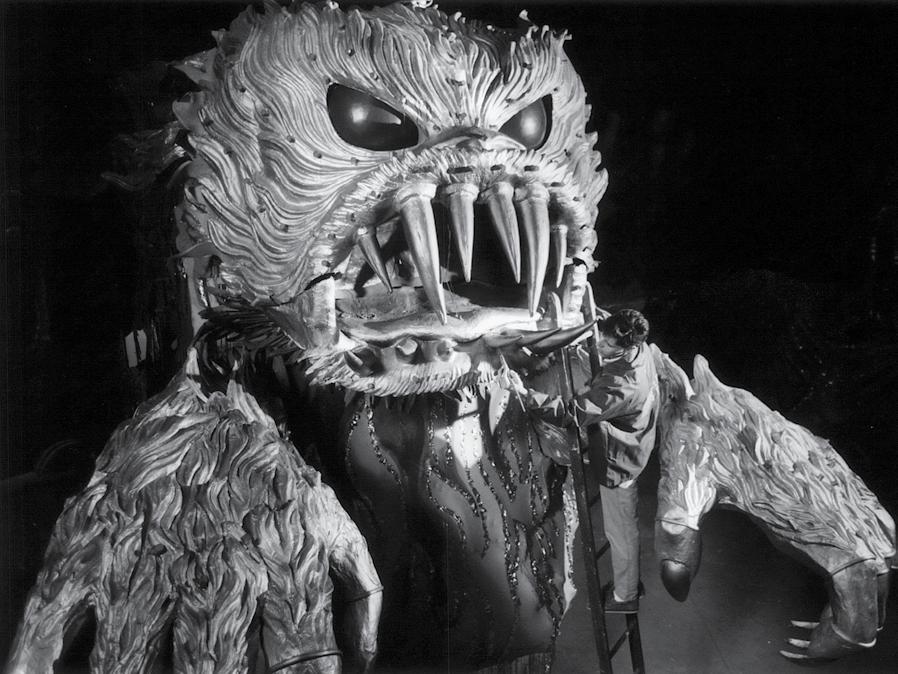




ABOUT THE COVER 1989
“A Mardi Gras Fantasy” by artist Steve St. Germain is his final cover for the Mardi Gras Guide and features a close-up view of a Mardi Gras reveler. Showing her bright colors, Art Deco fans, leopard spots, and streamers surrounding a pair of beautiful blue eyes, she is ready for the party.
Rex, the King of Carnival, celebrated his 125th anniversary. Three other krewes shared 50th anniversaries—Grela, Thoth, and the Crescent City Truck parade. A new parade called Knights of Camelot followed the Krewe of Carrollton parade. Le Krewe d’Etat, a new satirical club, was born. Televised coverage of the meetings of the courts began anew on WYES. A new policy by Jefferson Parish Sheriff Harry Lee to charge new clubs higher fees than existing ones resulted in a lawsuit by the Krewe of Neptune. Endymion introduced a new pre-parade celebration on Orleans Avenue called Samedi Gras. In New Orleans, Ashanti merged with the new Krewe of Vesta. Bacchus was Dick Clark, while Donna Summer rode as Endymion’s headliner.

ABOVE: The massive “Leviathan” float turns onto St. Charles Avenue as Orpheus rolls on Lundi Gras. MICHAEL DEMOCKER / THE TIMES-PICAYUNE
Darryl Montana wears his Black Masking Indian chief suit. THE TIMES-PICAYUNE
OPPOSITE: Revelers celebrate Fat Tuesday on Bourbon Street. THE TIMES-PICAYUNE
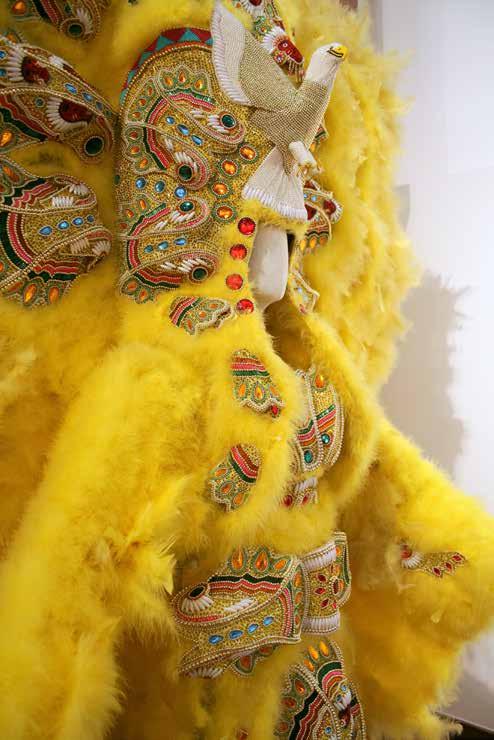
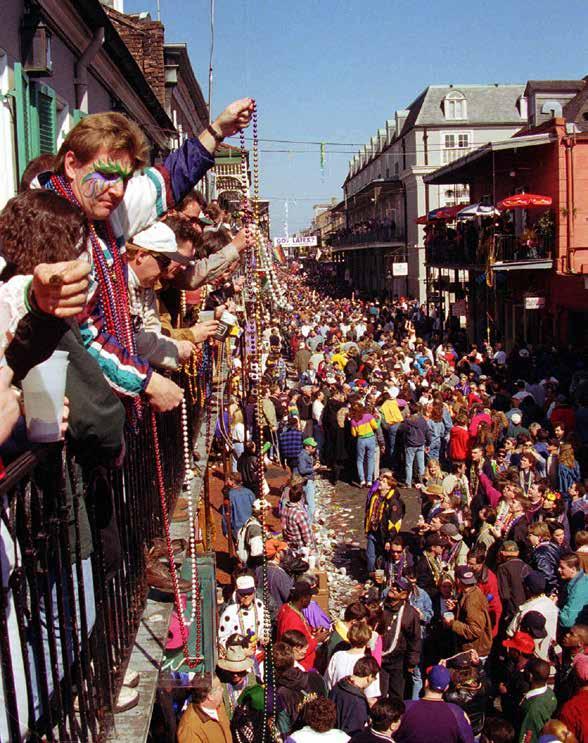

ABOUT THE COVER 1997
On the occasion of the 125th anniversary of Rex, artist David Johnson has captured the King of Carnival toasting his loyal subjects and proclaiming Mardi Gras to be a day of celebration and brotherhood throughout the city of New Orleans. How willingly we obey his royal edict each year, as we and thousands of visitors take to the streets and demonstrate our capacity to enjoy the good times with friends, family, and strangers alike. Perhaps one day we may persuade Rex to remain all year to make our city a symbol of goodwill and harmony throughout the world. Long live the king!

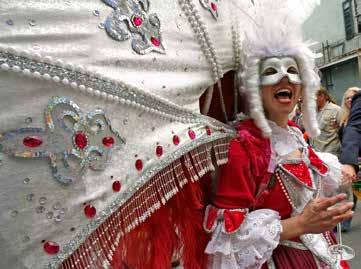
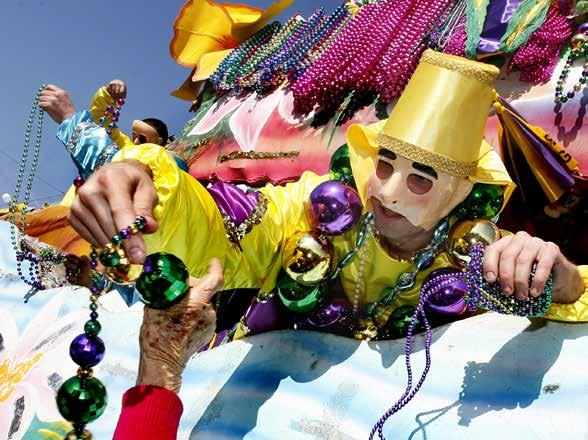

ABOUT THE COVER 2007
Illustrated by artist David Johnson, the King of Carnival has a message for friends and family of the Big Easy. And the message is “Come to the Mardi Gras!” Book a flight, pack your car, or get on board the City of New Orleans, but get yourself down here and join us as we celebrate our survival, our rebirth, and our joy of life! Stay at one of our four-star hotels, enjoy our world-class restaurants, shop and play in our historic French Quarter, and take a front row seat at the greatest free show on earth—Mardi Gras. Pay us a visit this Carnival season—we promise to give you your money’s worth!
With Fat Tuesday falling on February 5—the earliest in history—crowds were smaller with the parade season starting three weeks after Christmas and spring break nowhere in sight. The televised Eli Manning Super Bowl coinciding with the Bacchus parade, Super Tuesday primaries, which kept the media away, and horrible weather two of the 10 parade days, all contributed to the decline in parade attendance. The only significant reminder of Hurricane Katrina was the still shuttered Municipal Auditorium. Hulk Hogan rode as Bacchus, Kevin Costner led Endymion, and Helio Castroneves served as the monarch of Orpheus. The Krewe of Jason folded in Metairie. Endymion returned to its traditional Mid-city route. after a two-year absence. The Atlas and Gladiators parades returned to the lineup.

ABOVE: Pete Fountain leads the day with his group of marchers on Mardi Gras. He hands out beads to a woman near Canal Street and St. Charles Avenue.
CHRIS GRANGER / THE TIMES-PICAYUNE
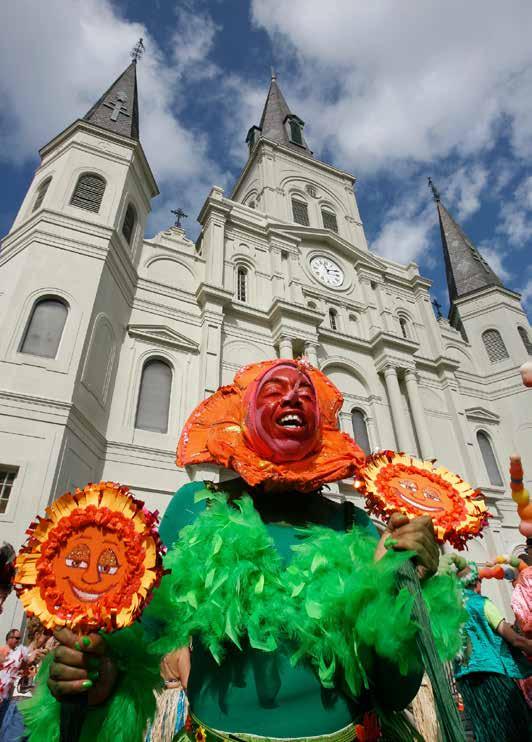
Tulane University’s economic study declared Carnival’s 2023 impact as $890 million. Carnival lost one of its leaders with the death of Ed Muniz, captain and founder of the Krewe of Endymion. The state of Louisiana celebrated the 325th anniversary of French explorer Iberville’s using the words “Mardi Gras” to name the site where he landed on March 3, 1699, on Fat Tuesday. The Krewe of Carrollton celebrated its 100th anniversary. Metairie lost its oldest truck parade, the Krewe of Jefferson, founded in 1974. Following the death of its captain, the Krewe of Little Rascals did not parade. Culinary Queens canceled very late in the season. For the third year in a row, the new Krewe of Caerus was a no-show. Two new Jefferson Parish parades included the Krewes of Music and Nandi, both of which paraded in Marrero. The traditional Fat Tuesday parade in Covington changed formats and is now known as the Krewe of Bogue Fayala.
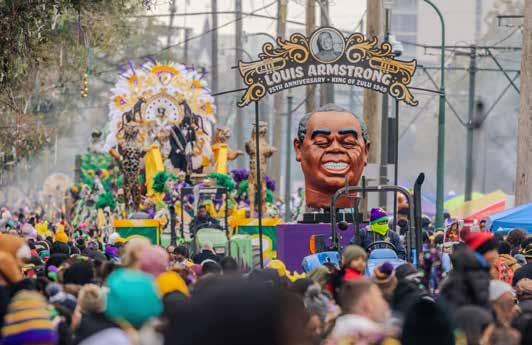
ABOVE RIGHT: A float featuring the likeness of Louis Armstrong leads the way in the Zulu parade. CHRIS GRANGER / THE TIMES-PICAYUNE
OPPOSITE TOP: The Societé of St. Anne makes its way to Canal Street.
DAVID GRUNFELD / THE TIMES-PICAYUNE
OPPOSITE BOTTOM: The Krewe of Orpheus parades on Lundi Gras.
CHRIS GRANGER / THE TIMES-PICAYUNE
RIGHT: The Amelia EarHawts and Cabin Krewe wave to the crowds gathered along the Krewe of Iris parade route. CHRIS GRANGER / THE TIMES-PICAYUNE




ABOUT THE COVER 2024
The spirit of Mardi Gras has persisted for 325 years since French explorer Iberville landed in Louisiana and named the spot Pointe du Mardi Gras. Since then, Mardi Gras has survived all challenges and exploded into an infinite variety of shapes, customs, and celebrations. Our 2024 cover, by David Johnson, illustrates the start of it all and some of the many Carnival icons we’ve come to know over the years.
